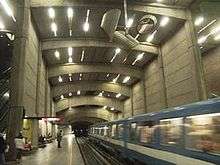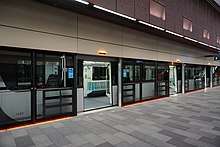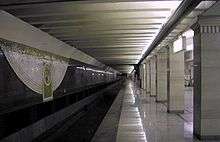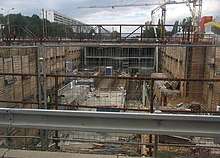Rapid transit technology
Rapid transit technology is technology used for public, mass rapid transit. Such transit is commonly known as a Metro or Subway, and it has undergone significant changes in the years since the Metropolitan Railway opened publicly in London in 1863.[1][2]
Train size
Some urban rail lines are built to a loading gauge as large as that of main-line railways; others are built to smaller and have tunnels that restrict the size and sometimes the shape of the train compartments. One example is the London Underground which has acquired the informal term "tube train" due to its cylindrical cabin shape.
In many cities, metro networks consist of lines operating different sizes and types of vehicles. Although these sub networks are not often connected by track, in cases when it is necessary, rolling stock with a smaller loading gauge from one sub network may be transported along other lines that use larger trains.
Motive power
Although initially the trains of what is now the London Underground were drawn by steam engines, virtually all metro trains, both now and historically, use electric power and are built to run as multiple units. Power for the trains, referred to as traction power, usually takes one of two forms: an overhead line, suspended from poles or towers along the track or from structure or tunnel ceilings, or a third rail mounted at track level and contacted by a sliding "pickup shoe". The practice of sending power through rails on the ground is mainly due to the limited overhead clearance of tunnels, which physically prevents the use of overhead wires. The use of overhead wires allows higher power supply voltages to be used. Although overhead wires are more likely to be used on metro systems without many tunnels, an example of which is the Shanghai Metro, overhead wires are employed on some systems that are predominantly underground, as in Barcelona, Fukuoka, Madrid, and Shijiazhuang. Both overhead wire and third-rail systems usually use the running rails as the return conductor, but some systems use a separate fourth rail for this purpose. There are transit lines that make use of both rail and overhead power, with vehicles able to switch between the two such as Blue Line in Boston.
Tracks

Most rapid transit systems use conventional standard gauge railway track. Since tracks in subway tunnels are not exposed to rain, snow, or other forms of precipitation, they are often fixed directly to the floor rather than resting on ballast, such as normal railway tracks.
An alternate technology, using rubber tires on narrow concrete or steel roll ways, was pioneered on certain lines of the Paris Métro, and the first completely new system to use it was in Montreal, Canada. On most of these networks, additional horizontal wheels are required for guidance, and a conventional track is often provided in case of flat tires and for switching. There are also some rubber-tired systems that use a central guide rail, such as the Sapporo Municipal Subway and the NeoVal system in Rennes, France. Advocates of this system note that it is much quieter than conventional steel-wheeled trains, and allows for greater inclines given the increased traction of the rubber tires.
Some cities with steep hills incorporate mountain railway technologies in their metros. One of the lines of the Lyon Metro includes a section of rack (cog) railway, while the Carmelit, in Haifa, is an underground funicular.
For elevated lines, another alternative is the monorail, which can be built either as straddle-beam monorails or as a suspended monorail. While monorails have never gained wide acceptance outside Japan, there are some such as Chongqing Rail Transit's monorail lines which are widely used in a rapid transit setting.
Crew size and automation
In the early days of underground railways, at least two staff members were needed to operated each train: one or more attendants (also called "conductor" or "guard") to operate the doors or gates, as well as a driver (also called the "engineer" or "motorman"). The introduction of powered doors around 1920 permitted crew sizes to be reduced, and trains in many cities are now operated by a single person. Where the operator would not be able to see the whole side of the train to tell whether the doors can be safely closed, mirrors or closed-circuit TV monitors are often provided for that purpose.

A replacement system for human drivers became available in the 1960s, with the advancement of computerized technologies for automatic train control and, later, automatic train operation (ATO). ATO could start a train, accelerate to the correct speed, and stop automatically in the correct position at the railway platform at the next station, while taking into account the information that a human driver would obtain from lineside or cab signals. The first metro line to use this technology in its entirety was London's Victoria line, opened in 1968. In normal operation, a crew member sits in the driver's position at the front, but is only responsible for closing the doors at each station. By pressing two "start" buttons the train would then move automatically to the next station. This style of "semi-automatic train operation" (STO), known technically as "Grade of Automation (GoA) 2", has become widespread, especially on newly built lines like the BART network in the San Francisco Bay Area.
A variant of ATO, "driverless train operation" (DTO) or technically "GoA 3", is seen on some systems, as in London's Docklands Light Railway, which opened in 1987. Here, a "passenger service agent" (formerly called "train captain") would ride with the passengers rather than sit at the front as a driver would, but would have the same responsibilities as a driver in a GoA 2 system. This technology could allow trains to operate completely automatically with no crew, just as most elevators do. When the initially increasing costs for automation began to decrease, this became a financially attractive option for employers. At the same time, countervailing arguments stated that in an emergency situation, a crew member on board the train would have possibly been able to prevent the emergency in the first place, drive a partially failed train to the next station, assist with an evacuation if needed, or call for the correct emergency services and help direct them to the location where the emergency occurred. In some cities, the same reasons are used to justify a crew of two rather than one; one person drives from the front of the train, while the other operates the doors from a position farther back, and is more conveniently able to assist passengers in the rear cars. An example of the presence of a driver purely due to union opposition is the Scarborough RT line in Toronto.
Completely unmanned trains, or "unattended train operation" (UTO) or technically "GoA 4", are more accepted on newer systems where there are no existing crews to be displaced, and especially on light metro lines. One of the first such systems was the VAL (véhicule automatique léger or "automated light vehicle"), first used in 1983 on the Lille Metro in France. Additional VAL lines have been built in other cities such as Toulouse, France, and Turin, Italy. Another system that uses unmanned trains is Bombardier's Innovia Metro, originally developed by the Urban Transportation Development Corporation as the Intermediate Capacity Transit System (ICTS). It was later used on the SkyTrain in Vancouver, British Columbia, which carries no crew members, and the Kelana Jaya Line in Kuala Lumpur, Malaysia.

Systems which use automatic trains also commonly employ full-height platform screen doors or half-height automatic platform gates in order to improve safety and ensure passenger confidence, but this is not universal, as networks like Nuremberg do not, using infrared sensors instead to detect obstacles on the track. Conversely, some lines which retain drivers or manual train operation nevertheless use PEDs, notably London's Jubilee Line Extension. The first network to install PSDs on an already operational system was Hong Kong's MTR, followed by the Singapore MRT.
As for larger trains, the Paris Métro has human drivers on most lines but runs automated trains on its newest line, Line 14, which opened in 1998. The older Line 1 was subsequently converted to unattended operation by 2012, and it is expected that Line 4 will follow by 2019. The North East MRT Line in Singapore, which opened in 2003, is the world's first fully automated underground urban heavy-rail line. The MTR Disneyland Resort Line is also automated, along with trains on the future South Island Line.
Tunnel construction
The construction of an underground metro is an expensive project and is often carried out over a number of years. There are several different methods of building underground lines.
In one common method, known as cut-and-cover the city streets are excavated and a tunnel structure strong enough to support the road above is built in the trench, which is then filled in and the roadway rebuilt. This method often involves extensive relocation of utilities commonly buried not far below street level – particularly power and telephone wiring, water and gas mains, and sewers. This relocation must be done carefully, as according to documentaries from the National Geographic Society, one of the causes of the April 22, 1992, explosions in Guadalajara was a mislocated water pipeline. The structures are typically made of concrete, perhaps with structural columns of steel; in the oldest systems, brick, and cast iron were used. Cut-and-cover construction can take so long that it is often necessary to build a temporary roadbed while construction is going on underneath, in order to avoid closing main streets for long periods of time.
Another usual type of tunneling method is called bored tunneling. Here, construction starts with a vertical shaft from which tunnels are horizontally dug, often with a tunneling shield, thus avoiding almost any disturbance to existing streets, buildings, and utilities. But problems with ground water are more likely, and tunneling through native bedrock may require blasting. The first city to extensively use deep tunneling was London, where a thick sedimentary layer of clay largely avoids both problems. The confined space in the tunnel also limits the machinery that can be used, but specialized tunnel-boring machines are now available to overcome this challenge. One disadvantage with this, however, is that the cost of tunneling is much higher than building cut-and-cover systems, at-grade or elevated. Early tunneling machines could not make tunnels large enough for conventional railway equipment, necessitating special low, round trains, such as are still used by most of the London Underground, which cannot install air conditioning on most of its lines because the amount of empty space between the trains and tunnel walls is so small. Other lines were built with cut-and-cover and have since been equipped with air-conditioned trains.
The deepest metro system in the world was built in St. Petersburg, Russia where in the marshland, stable soil starts more than 50 metres (160 ft) deep. Above that level, the soil mostly consists of water-bearing finely dispersed sand. Because of this, only three stations out of nearly 60 are built near ground level and three more above the ground. Some stations and tunnels lie as deep as 100–120 metres (330–390 ft) below the surface. However, the location of the world's deepest station is not clear. Usually, the vertical distance between the ground level and the rail is used to represent the depth. Among the possible candidates are:

- Deepest stations in Saint Petersburg Metro, Russia:
- Admiralteyskaya (The Admiralty, 102 metres (335 ft), opened 2011, probably the best candidate)
- Komendantsky Prospekt (The Commandant Avenue, 78 metres (256 ft), opened 2005)
- Chernyshevskaya (Chernyshevsky, 70 metres (230 ft), opened 1958)
- Ploshad Lenina (Lenin Square, 72 metres (236 ft), opened 1958)
- Arsenalna station in Kiev Metro, Ukraine (105.5 metres (346 ft), opened 1960, built under a hill)
- Hongtudi station in Chongqing Metro, China (94 metres (308 ft), opened in 2016)
- Liyuchi station in Chongqing Metro, China (76 metres (249 ft), opened in 2017)
- Park Pobedy station in Moscow (~80 metres (260 ft), opened 2005, built under a hill)
- Puhung station in Pyongyang Metro, North Korea (which doubles as a nuclear shelter)
- Washington Park MAX Light Rail station in Portland, Oregon (built under a hill), 260 feet (80 m)
One advantage of deep tunnels is that they can dip in a basin-like profile between stations, without incurring the significant extra costs associated with digging near ground level. This technique, also referred to as putting stations "on humps", allows gravity to assist the trains as they accelerate from one station and brake at the next. It was used as early as 1890 on parts of the City and South London Railway and has been used many times since, particularly in Montreal.
The West Island Line, an extension of the MTR Island Line serving western Hong Kong Island, opened in 2015, has two stations (Sai Ying Pun and HKU) situated over 100 metres (330 ft) below ground level, to serve passengers on the Mid-levels. They have several entrances/exits equipped with high-speed lifts, instead of escalators. These kinds of exits have existed in many London Underground stations and other stations in former Soviet Union nations.
References
- UITP (5 October 2011). "Recommended basic reference for developing a minimum set of standards for voluntary use in the field of urban rail, according to mandate M/486" (PDF). Archived from the original (PDF) on 22 February 2014. Retrieved 29 April 2019.
- "Glossary of Transit Terminology" (PDF). American Public Transportation Association. July 1994. Retrieved 29 April 2019.
